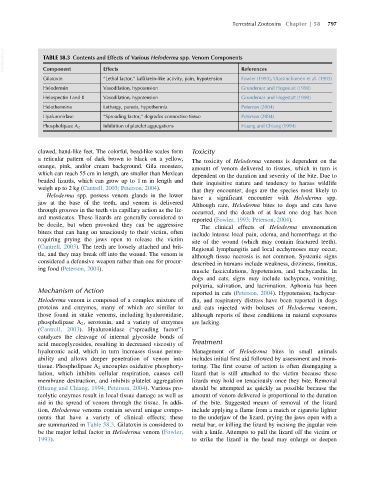Page 839 - Veterinary Toxicology, Basic and Clinical Principles, 3rd Edition
P. 839
Terrestrial Zootoxins Chapter | 58 797
VetBooks.ir TABLE 58.3 Contents and Effects of Various Heloderma spp. Venom Components References
Component
Effects
Gilatoxin “Lethal factor,” kallikrein-like activity, pain, hypotension Fowler (1993), Utaisincharoen et al. (1993)
Helodermin Vasodilation, hypotension Grundemar and Hogestatt (1990)
Helospectin I and II Vasodilation, hypotension Grundemar and Hogestatt (1990)
Helothermine Lethargy, paresis, hypothermia Peterson (2004)
Hyaluronidase “Spreading factor,” degrades connective tissue Peterson (2004)
Phospholipase A 2 Inhibition of platelet aggregations Huang and Chiang (1994)
clawed, hand-like feet. The colorful, bead-like scales form Toxicity
a reticular pattern of dark brown to black on a yellow,
The toxicity of Heloderma venoms is dependent on the
orange, pink, and/or cream background. Gila monsters,
amount of venom delivered to tissues, which in turn is
which can reach 55 cm in length, are smaller than Mexican
dependent on the duration and severity of the bite. Due to
beaded lizards, which can grow up to 1 m in length and
their inquisitive nature and tendency to harass wildlife
weigh up to 2 kg (Cantrell, 2003; Peterson, 2004).
that they encounter, dogs are the species most likely to
Heloderma spp. possess venom glands in the lower
have a significant encounter with Heloderma spp.
jaw at the base of the teeth, and venom is delivered
Although rare, Heloderma bites to dogs and cats have
through grooves in the teeth via capillary action as the liz-
occurred, and the death of at least one dog has been
ard masticates. These lizards are generally considered to reported (Fowler, 1993; Peterson, 2004).
be docile, but when provoked they can be aggressive The clinical effects of Heloderma envenomation
biters that can hang on tenaciously to their victim, often include intense local pain, edema, and hemorrhage at the
requiring prying the jaws open to release the victim site of the wound (which may contain fractured teeth).
(Cantrell, 2003). The teeth are loosely attached and brit- Regional lymphangitis and local ecchymoses may occur,
tle, and they may break off into the wound. The venom is although tissue necrosis is not common. Systemic signs
considered a defensive weapon rather than one for procur-
described in humans include weakness, dizziness, tinnitus,
ing food (Peterson, 2004).
muscle fasciculations, hypotension, and tachycardia. In
dogs and cats, signs may include tachypnea, vomiting,
polyuria, salivation, and lacrimation. Aphonia has been
Mechanism of Action reported in cats (Peterson, 2004). Hypotension, tachycar-
Heloderma venom is composed of a complex mixture of dia, and respiratory distress have been reported in dogs
proteins and enzymes, many of which are similar to and cats injected with boluses of Heloderma venom,
those found in snake venoms, including hyaluronidase, although reports of these conditions in natural exposures
phospholipase A 2 , serotonin, and a variety of enzymes are lacking.
(Cantrell, 2003). Hyaluronidase (“spreading factor”)
catalyzes the cleavage of internal glycoside bonds of
acid mucoglycosides, resulting in decreased viscosity of Treatment
hyaluronic acid, which in turn increases tissue perme- Management of Heloderma bites in small animals
ability and allows deeper penetration of venom into includes initial first aid followed by assessment and moni-
tissue. Phospholipase A 2 uncouples oxidative phosphory- toring. The first course of action is often disengaging a
lation, which inhibits cellular respiration, causes cell lizard that is still attached to the victim because these
membrane destruction, and inhibits platelet aggregation lizards may hold on tenaciously once they bite. Removal
(Huang and Chiang, 1994; Peterson, 2004). Various pro- should be attempted as quickly as possible because the
teolytic enzymes result in local tissue damage as well as amount of venom delivered is proportional to the duration
aid in the spread of venom through the tissue. In addi- of the bite. Suggested means of removal of the lizard
tion, Heloderma venoms contain several unique compo- include applying a flame from a match or cigarette lighter
nents that have a variety of clinical effects; these to the underjaw of the lizard, prying the jaws open with a
are summarized in Table 58.3. Gilatoxin is considered to metal bar, or killing the lizard by incising the jugular vein
be the major lethal factor in Heloderma venom (Fowler, with a knife. Attempts to pull the lizard off the victim or
1993). to strike the lizard in the head may enlarge or deepen

